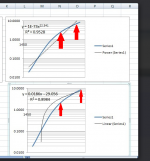Going where few (in this forum) had dare go before.
Pick your favorite diode, which one 'sounds' best?😉
Pick your favorite diode, which one 'sounds' best?😉
Attachments
-
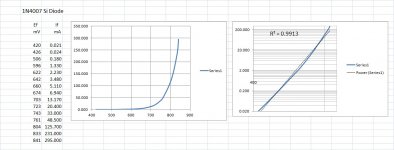 1N4007 Si Diode.jpg121.6 KB · Views: 213
1N4007 Si Diode.jpg121.6 KB · Views: 213 -
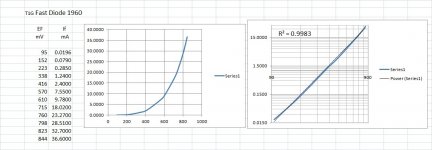 T1G Fast Diode 1960.jpg79.7 KB · Views: 182
T1G Fast Diode 1960.jpg79.7 KB · Views: 182 -
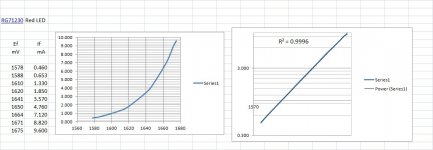 RG71230 Red LED.jpg76 KB · Views: 202
RG71230 Red LED.jpg76 KB · Views: 202 -
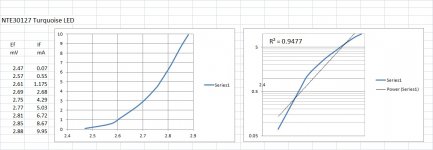 NTE30127 Turquoise LED.jpg94.9 KB · Views: 195
NTE30127 Turquoise LED.jpg94.9 KB · Views: 195 -
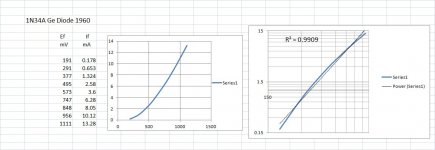 1N34A Ge Diode 1960.jpg69.6 KB · Views: 197
1N34A Ge Diode 1960.jpg69.6 KB · Views: 197 -
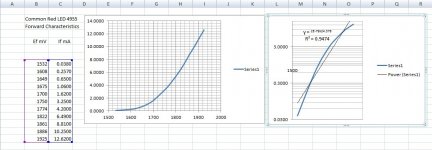 Common Red LED 4955 Forward Characteristics.jpg103.1 KB · Views: 187
Common Red LED 4955 Forward Characteristics.jpg103.1 KB · Views: 187 -
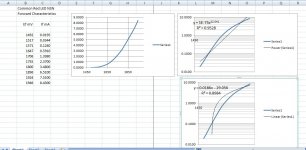 Common Red LED NSN Forward Characteristics.jpg110.7 KB · Views: 191
Common Red LED NSN Forward Characteristics.jpg110.7 KB · Views: 191 -
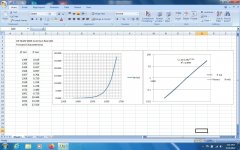 HP HLMP 4855 Common Red LED Forward Characteristics.jpg204.3 KB · Views: 193
HP HLMP 4855 Common Red LED Forward Characteristics.jpg204.3 KB · Views: 193
I could make a long list of places small diodes are used, but why don't you tell us what you have in mind?
I wish some company would make one of those bridge controller chips for mosfets but rated for 1kv or so.
The controller runs from the incoming ac and tops out at 72 volts or something like that. Wondered about dividing down the input but that seems kind of iffy. Use a separate winding for the chip but you couldn’t have any phase shift between the sources.
Additional problem with controller chip and MOSFETs is that it is designed for capacitor input filters only, so it just substituted one kind of PSU noise with another.
That's nice! What do they do?? 🙂What's the sound of one hand clapping?
I tend to use HER... HER108, 208, 308.
I use them as rectifiers for tube stuff. Maybe there are newer parts but the HER works for me. Stands for High Efficiency Rectifier apparently.
For small signals, I'm using 1N4148 or similar still.
For small signals, I'm using 1N4148 or similar still.
A wakeup call to all those stuffing diodes into the cathode of a voltage amplifier.I could make a long list of places small diodes are used, but why don't you tell us what you have in mind?
With the exception of that very pretty turquoise LED, all these are square law devices.
The closer R^2 is to One the better fit to Square Law.
People talk on & on about the linearity of this or that boutique resister & than stuff in a non-linear device.
And most always with no knowledge of its electrical effect.
It seems they are choosing on the basis of best 'sound', something not reproducible somewhere else.
When a diode is bought for that purpose it is a crap shoot what the result will be.
In some recent tests in the cathode of a 12AX7 I found the D% was higher in every case.
Go ahead & list your small diodes, if they are alive & well they will be Square Law.
Square Law is a very useful property at RF & MW for measuring systems looking a QAM.
Check Boonton & Keysite. And yes, I sold some of those as I was finishing up in the hitech buz.
At 78 it was time to let the 7AM flight to leave without me.😎
A wakeup call to all those stuffing diodes into the cathode of a voltage amplifier.
Тhanks for bringing this up. Many years ago i had a brief cathode/led biasing period. Listened to practically all the leds i had and only the ones that came out of a broken old music centre sounded any good. None of my current stock was at all usable. Which caused a lot of headscratching, but it never crossed my mind there could be a scientifically plausible explanation.
This is the classical and best solution. No problems of higher Rp, distortion, and diminished gain of unbypassed cathode resistor, or quality of bypassing capacitor.Replace the diode with a battery and check distortion...
Yes, but it can charge the battery in that position... Not all batteries like that - most don't.This is the classical and best solution. No problems of higher Rp, distortion, and diminished gain of unbypassed cathode resistor, or quality of bypassing capacitor.
You can instead just ground the cathode, and put the battery in series with the grid and signal like Mr Broskie shows in this pic. Bonus - No current flows when it's off, and probably µA when it's on. They last for decades if you use a carbon cell.
My "spidey sense" tells me it's a 6DJ8 tube.
An active bridge is pointless above 0.65 x100 = 65V.
Not a tube fan, but any kind of cathode bias is crude squared.
Not a tube fan, but any kind of cathode bias is crude squared.
FYI it's very easy to fit the SPICE parameters IS, N, and RS. The parameter called RS is the equivalent series resistance, and it is what makes the I-V curve bend to the right (less upwards) at higher diode current.
I show exactly how I did this in post #38 of another thread ... ... back in 2016. If I can do it, you can do it.
_
I show exactly how I did this in post #38 of another thread ... ... back in 2016. If I can do it, you can do it.
_
Attachments
A lot of people seem to like the sound of (some) non-linearity in their "Hi-Fi" sound. Adding harmonic distortion to the input audio signal is most definitely not Hi-Fi, but there it is. Why else would people prefer tubes? In recent decades, well designed solid-state circuits are far more linear.People talk on & on about the linearity of this or that boutique resister & than stuff in a non-linear device.
If you actually want Hi-Fi, stick with reasonably low-distortion solid state amplification. If you want pleasantly distorted audio (which is not Hi-Fi by definition), then tubes and diodes and other nonlinear things seem attractive.
Records (black plastic discs with little needles dragging in grooves...) also produce lots of harmonic distortion, particularly near the center of the record, where recorded wavelengths get very short, and the playback stylus is unable to follow the same path as the knife-edged cutting stylus did when the record was made. This used to be called "tracing distortion" IIRC.
I remember how the sound got audibly harsher and harsher as the pickup moved closer and closer to the centre of the LP, and second-harmonic distortion climbed way up in lock-step.
The amount of THD generated this way was much worse in the era of conical stylus profiles, got better when elliptical tips came along, and got a little better again when hyper-elliptical tips arrived. But the playback stylus can never have the same sharp knife-edged profile as the cutting stylus, otherwise it would tear up the record on playback. And that means it can never follow the same path that the cutting stylus did. Ergo, THD, mostly 2nd harmonic.
I think people who grew up with vinyl came to like this extra harmonic distortion, and that is one of the reasons (along with nostalgia and album cover art and album liner notes) why some people say they prefer the distorted sound from records to the accurate sound from good digital audio. Either that, or these people actually like hearing surface hiss, ticks, pops, wow, rumble, limited stereo separation, limited deep bass, and all the other ills that plague records.

Back on the topic of nonlinear distortion from diodes, I remember seeing a published circuit for a device that was supposed to enhance the quality of music signals. Basically, this doodad split off some of the input audio signal, fed it through a silicon diode, tapped off a little of the distorted voltage across the diode, and mixed that back in with the incoming signal before spitting it out.
The device was labelled as an "exciter" or "enhancer" or something, but what it was actually doing was adding a few percent of mostly second harmonic distortion, and some inevitable IMD with it. Evidently some people liked this added distortion enough to buy / build this sort of circuit.
In addition to the worse harmonic distortion you pointed out, the other bad thing about using an LED to replace a cathode resistor, is that it worsens operating point stability. For good stability you want (d Ia)/(d Vgk) to be as small as possible, so that small changes in bias voltage don't cause the anode current to change.
Wanting low dI/dV is the same as saying you want high dV/dI. That means a large dynamic resistance.
A forward biased diode has exactly the opposite - a very low dV/dI. Much less than the cathode resistor it replaces. This low dynamic resistance is the whole reason why you don't need a cathode bypass capacitor any more. But the same low dynamic resistance also makes the circuit highly sensitive to slight variations in Vgk. Tube swaps and tube aging are likely to move the DC operating point all over the map (lots of change in static anode current, compared t using a suitable-value cathode resistor).
I really wonder about the benefits of trading off a stable operating point in exchange for getting rid of a cathode bypass cap. Electrolytic caps have done that job very well for decades, but for those who must turn up their noses at electrolytics, you can get expensive and bulky film caps in the sort of values needed.
And if you're pragmatic, but want something with longer life than an aluminium electrolytic cap, these days there are cheap-as-chips multi-layer ceramic caps available up to values of a few tens of microfarads, in voltage ratings that make them perfect for cathode bypass duties. I have been using these in my tube guitar amp builds for some years now.
-Gnobuddy
Tubes sound great for electric guitar amplification. But not because tubes are linear and wonderful - they sound great because tubes are nonlinear, and simple tube circuits misbehave a lot. Tube amps have so very many flaws - but those flaws cover up the bland and boring sounds made by solid-body electric guitars quite well. 🙂Not a tube fan, but any kind of cathode bias is crude squared.
Tubes for Hi-Fi, on the other hand, have never made the slightest sense to me. Hi-Fi is about inaudibly low levels of distortion; solid state amplifiers have been doing that job very well for decades now. And they do it at lower cost, at higher power, with less noise, for less money, with less heat, less weight, more durability, and longer lives. What's not to like?

-Gnobuddy
I'm not as knowledgeable as some of you all, so I hope you're willing to entertain a possibly dumb question...
Used as a cathode load for a triode common cathode voltage amplifier, wouldn't the 'best' device be the one that gives you the most constant (and a usable) Vf over the widest range of Ip through the tube? In that case, using a red LED at Ip > or = 5mA should work pretty well... No?
The Common Red LED gives Vf = 1.79V at Ip = 5mA, and Vf = 1.88V at Ip = 10mA. That's a variance of only Vf = 0.09V over a range of Ip = 5mA to 10mA. Is that so bad?
PS - If you have LPs or 78s you want to play, I see no reason why one shouldn't use tubes or whatever other audio sweetening devices one wants in that application. But now that digital sources have finally started to sound really good (imo), I'm finding my old tube sweetening devices just make digital sources sound worse (muddy, 'closed in'). So, I use a tube preamp for vinyl and the simplest solid-state signal chain I can for digital. That's working for me...
Used as a cathode load for a triode common cathode voltage amplifier, wouldn't the 'best' device be the one that gives you the most constant (and a usable) Vf over the widest range of Ip through the tube? In that case, using a red LED at Ip > or = 5mA should work pretty well... No?
The Common Red LED gives Vf = 1.79V at Ip = 5mA, and Vf = 1.88V at Ip = 10mA. That's a variance of only Vf = 0.09V over a range of Ip = 5mA to 10mA. Is that so bad?
PS - If you have LPs or 78s you want to play, I see no reason why one shouldn't use tubes or whatever other audio sweetening devices one wants in that application. But now that digital sources have finally started to sound really good (imo), I'm finding my old tube sweetening devices just make digital sources sound worse (muddy, 'closed in'). So, I use a tube preamp for vinyl and the simplest solid-state signal chain I can for digital. That's working for me...
Last edited:
- Home
- Amplifiers
- Tubes / Valves
- Some Common Diode Forward Characteristics
